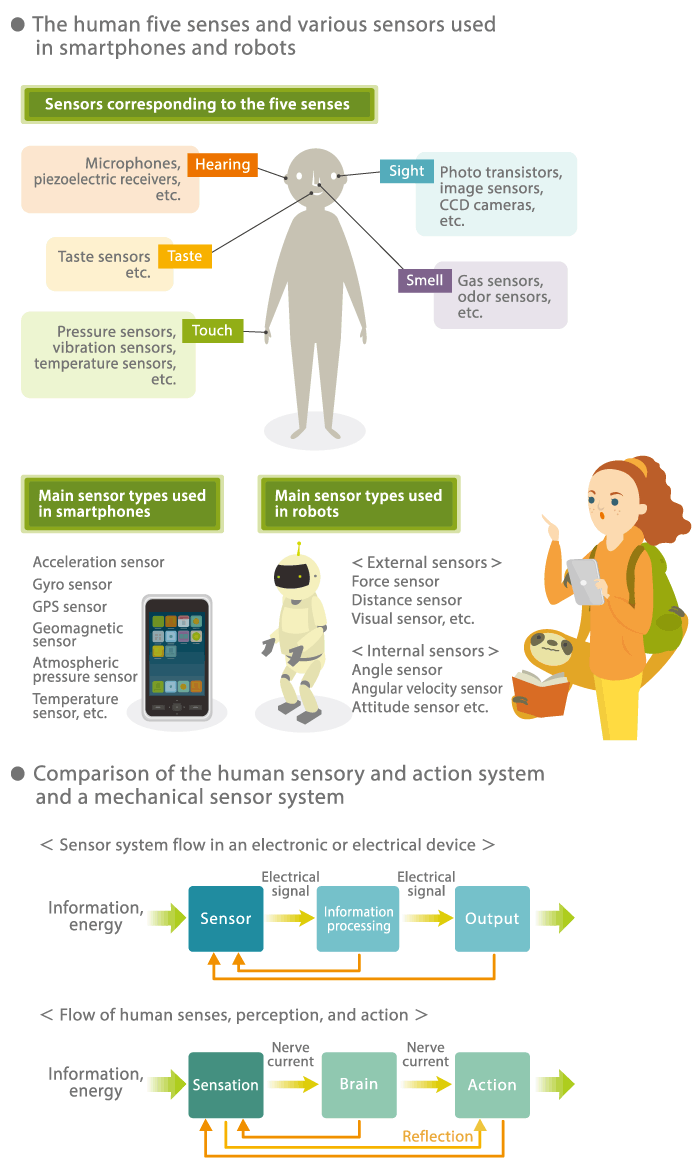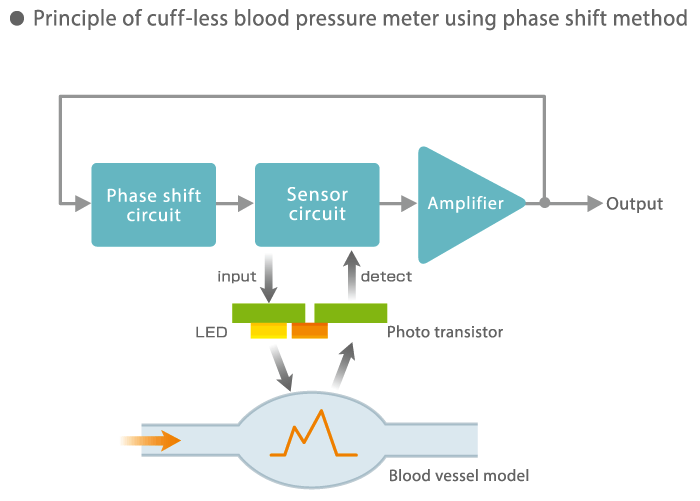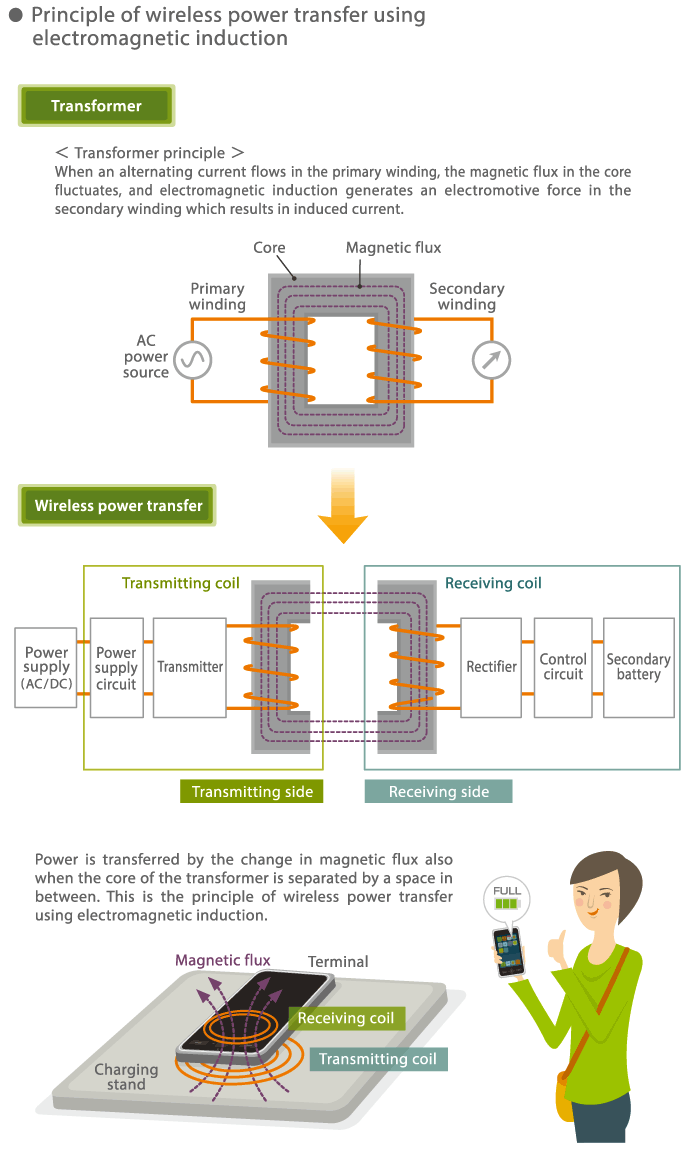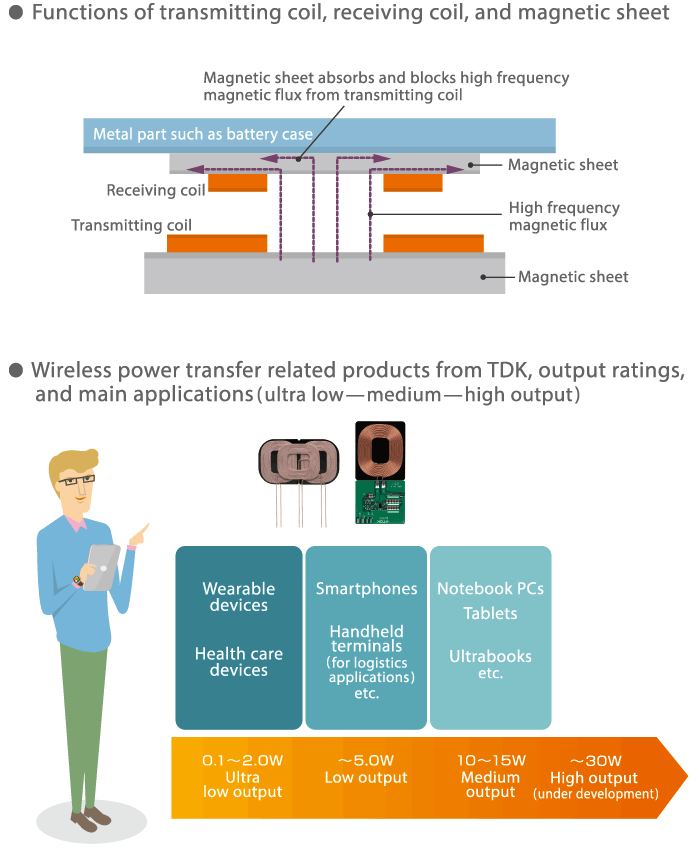Knowledge Box
Vol.3 Wireless Power Transfer Systems for Wireless Healthcare Devices
Smartphones and tablet devices incorporate a variety of sensing elements, including acceleration, gyro, pressure, temperature, and GPS sensors, and their number continues to increase from year to year. This development has even led to the creation of a new term, "sensor hub" that is heard quite frequently these days. In a conventional arrangement, where information from each individual sensor is processed by the CPU, power consumption will increase with the number of sensors.

Wearable blood pressure meter allowing 24-hour monitoring soon to be a reality
The task of a sensor is to detect information or energy from an object and convert it into an electrical signal. Various types of sensors corresponding to the human five senses (sight, hearing, smell, taste, touch) are being used extensively in electronic devices and electrical equipment. Going beyond simply processing the sensor signal for output, it is also possible to provide feedback to the sensor side, thereby achieving optimized control and enabling capabilities such as autonomous driving.
Sensors for vital signs including respiratory rate and heart rate, blood pressure and blood sugar levels will be indispensable for wearable health care devices. People are growing more health conscious, and in keeping with this trend, various activity meters for example in wristband or wristwatch form have come onto the market. A low-power pairing technology called Bluetooth Low Energy (BLE) is being used to wirelessly connect smartphones and similar to such hub devices. Simply by wearing suitable device on one's body, it is possible to realize 24-hour, 365-day health management through sensors for vital signs including number of steps walked, distance traveled, heart rate, calories consumption, and more.
A variety of new components for wearable applications have also been developed. One of these is the SESUB-PAN-T2541 from TDK which harnesses proprietary semiconductor embedded substrate (SESUB) technology to realize a tiny BLE communication module. In combination with a battery and suitable sensor, it can becomes a wearable pulse rate meter. TDK also supplies atmospheric pressure sensors and a variety of other sensor products. For example, by incorporating a combination of small sensors TDK also supplies acceleration sensors, atmospheric pressure sensors and similar products. For example, by using an acceleration sensor to provide attitude information and incorporating it in a fashionable bracelet or necklace type wearable device, a system for protecting elderly persons from falls can be devised.
However, one vital sign that is still difficult to measure while a person is in motion is blood pressure. In addition to traditional blood pressure meters using a mercury column (Korotkoff method), electronic blood pressure monitors (oscillometric method) for home use have been developed, but all of these require a cuff (pneumatic tourniquet) to put pressure on the upper arm or wrist, temporarily stopping the blood flow for measurement. Until recently, no meter for continuously measuring blood pressure without oppression was available.
However, wearable cuff-less blood pressure monitors are now being developed. A prototype created by Nihon University is a new kind of blood pressure meter that uses the phase shift method to perform measurement by simple touch. Near infrared light from a LED source irradiates the skin, and changes in the waveform of the reflected light are detected to calculate the blood pressure value using a unique algorithm. The dedicated chip for the system measures a mere square centimeter, which should enable integration into a wearable device of the wristband or wristwatch type, thereby realizing continuous blood pressure monitoring.

Simple and low-cost wireless charging system using electromagnetic induction
The biggest challenge in the evolution of wearable health care devices is the battery problem. Small dimensions and light weight are absolute requirements of a wearable device, which naturally limits the size of the battery that can be fitted. Wireless charging, also called wireless power transfer, is a key approach towards providing a solution to this problem.
Various principles to realize wireless charging are possible, including electromagnetic induction and magnetic resonance. The former has been in use already for a considerable time. It involves a transmitting coil in a charging stand which generates a magnetic flux from an AC power source. This flux in turn is picked up by a receiving coil that converts it back into power. With a maximum of about 10 mm, the possible transmission distance of such a system is short, but construction is simple, costs can be kept low, and reliability is high. The so-called Qi standard created by the Wireless Power Consortium (WPC) for wireless charging of smartphones and other mobile devices also uses the electromagnetic induction principle .

Compact low power wireless power transfer system ideal for charging health care devices
TDK is an industry-leading supplier of coil units for wireless power transfer, offering extremely thin and lightweight products that also feature excellent shock resistance, high reliability and WPC standard compliance. The company is also currently developing extremely compact low power wireless transfer coils for wearable health care devices. These will be suitable for use in wristband, wristwatch, ring, or eyeglass type wearables, enabling the wireless charging of such devices from a charger stand. Unlike with conventional products that are charged via a USB terminal or similar, this eliminates the problem of easily damaged external connectors. Another important advantage is the fact that eliminating connectors also makes it much easier to design waterproof and dustproof products.
The receiving coils for wireless power transfer applications must have magnetic shielding on the rear, which is usually achieved by means of a magnetic sheet (ferrous magnetic sheet or similar). Otherwise, if there are metallic surfaces such as a battery case in close proximity, the high frequency magnetic flux from the transmitting coil may cause Joule heat loss due to eddy currents which in turn can lead to overheating. Proper design of the magnetic sheet for the coil therefore is an important technological consideration. The TDK product lineup comprises a wide range of high-performance magnetic sheets, including types rated for high shock resistance, flexibility, or extra thinness. Furthermore, TDK offers comprehensive solutions including transmitting and receiving coils, chip modules, and more.

Compact low power wireless power transfer systems from TDK can free the users of wearable devices as well as of other battery powered small electronic devices from the cumbersome need to frequently replace tiny button batteries. Other possible applications in the medical sector include ultrasonic instruments as well as probes for electrocardiogram measurements. By incorporating wireless charging capability, probes can be made more versatile and more hygienic.
Besides medium power applications for mobile devices and low power applications for wearables, TDK is also exploring the field of high power wireless charging, which is ideal for notebook computers and similar. Suitable coils are currently under development and will expand the TDK product lineup still further. Besides a formidable array of sensors, TDK also has a variety of products and expertise in other areas that can be applied to wearable health care equipment, such as film type flexible photovoltaic cells and electric double-layer capacitors (EDLC). This is another forte of TDK that promises more to come in the near future.
TDK is a comprehensive electronic components manufacturer leading the world in magnetic technology







